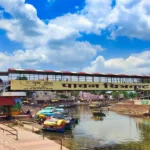History and Renaming of Ayodhya Junction to Ayodhya Dham Junction
Ayodhya Junction, a key railway station located in the historically and spiritually significant city of Ayodhya in Uttar Pradesh, India, has recently undergone a significant transformation.
The station, known for decades as Ayodhya Junction, has been a pivotal point for pilgrims and travellers visiting the city, which holds immense religious significance in Hindu culture as the birthplace of Lord Ram.
In a move reflecting the city’s cultural importance and in response to public sentiment, the station was renamed Ayodhya Dham Junction. This renaming was part of a larger redevelopment project aimed at modernizing the station while preserving and showcasing the area’s rich heritage.

The name change to Ayodhya Dham Junction was officially announced by Lallu Singh, a Member of Parliament from Ayodhya, and was guided by the Prime Minister of India, Shri Narendra Modi.
This change symbolizes a deeper connection with the spiritual and cultural identity of Ayodhya, aligning the station’s identity more closely with the city’s historical and religious significance.
The redevelopment of Ayodhya Junction into Ayodhya Dham Junction is not just a name change but also a part of a broader initiative to upgrade the railway infrastructure to better serve the increasing number of pilgrims and tourists visiting Ayodhya.
The renovation includes modern amenities, enhanced passenger facilities, and architectural elements inspired by local culture and religious symbols.
In summary, the transformation of Ayodhya Junction into Ayodhya Dham Junction represents a significant milestone in Ayodhya’s journey, blending modernity with tradition. This change not only enhances the travel experience for visitors but also strengthens Ayodhya’s status as a key destination for pilgrimage and cultural tourism.
Key Architectural Features
Cultural Reflections in Design: The new station building at Ayodhya Dham Junction is designed to portray the local culture and heritage of Ayodhya. The architecture is heavily inspired by elements found in Hindu temples, resonating with the spiritual significance of the city.
Symbolic Elements: The design incorporates symbolic structures reminiscent of those found in Hindu mythology. For instance, Lord Ram’s ‘mukut’ (crown) is a prominent feature in the design, along with the ‘chakra’, symbolizing the sun. These elements not only add to the aesthetic appeal of the station but also connect deeply with the religious sentiments of the visitors.

Size and Scale: The station’s new building has a substantial built-up area, considerably larger than the previous structure. This expansion significantly increases the station’s capacity to handle a higher volume of passengers, reflecting the growing importance of Ayodhya as a tourist and pilgrimage destination.
Environmentally Conscious Design: In line with modern architectural trends, the station incorporates several eco-friendly features. These include the use of solar panels for clean energy generation and rainwater harvesting systems, demonstrating a commitment to sustainability.
Amenities for Comfort and Convenience: The station is equipped with modern amenities like escalators, lifts, and ramps to ensure accessibility for all passengers. The inclusion of these features makes the station a convenient and comfortable transit point for travelers.
Integration with the Surrounding Environment: The design of Ayodhya Dham Junction is mindful of its surroundings, integrating seamlessly with the urban landscape of Ayodhya while still standing out as a landmark.
By embodying the essence of Ayodhya’s rich history and cultural significance in its architecture, Ayodhya Dham Junction serves as more than just a transit point; it’s a gateway to the spiritual and cultural journey that Ayodhya offers.
The blend of traditional motifs and modern facilities makes it a perfect example of how contemporary architecture can pay homage to the past while catering to the needs of the present.
Key Modern Amenities at Ayodhya Dham Junction
Increased Capacity and Comfort: The redeveloped Ayodhya station boasts a much larger area compared to its predecessor, equipped to handle an increased number of passengers. This expansion includes multiple levels, ensuring more space and comfort for travellers.
Advanced Passenger Facilities: The station features modern facilities such as escalators and elevators, making it accessible to everyone, including elderly and differently-abled passengers. These facilities represent a significant improvement in the station’s infrastructure.
Eco-Friendly Features: Ayodhya Dham Junction has embraced sustainability with the implementation of eco-friendly features. Solar panels for clean energy and efficient waste management systems are just some examples of its green initiatives.

Comprehensive Services: The station is equipped with amenities like waiting rooms, cloakrooms, and childcare facilities, catering to the diverse needs of passengers. Additionally, the station houses food plazas and retail stores, providing a variety of dining and shopping options.
Enhanced Security and Safety: The station’s security system has been upgraded with the installation of CCTV cameras and emergency services, ensuring a safe environment for passengers.
Cultural and Spiritual Shops: Reflecting the spiritual significance of Ayodhya, the station includes shops catering to the needs of pilgrims, such as those selling puja items.
Improved Sanitation Facilities: The station has seen a significant upgrade in its sanitation facilities, with the development of modern washrooms equipped with adequate urinals and lavatories.
Parking and Taxi Services: A new, larger parking area has been constructed to accommodate the increased vehicular traffic. This includes a dedicated taxi booth, enhancing connectivity to the city.
The redevelopment of Ayodhya Junction into Ayodhya Dham Junction with these modern amenities not only improves the functionality and aesthetic appeal of the station but also aligns it with the growing stature of Ayodhya as a major pilgrimage and tourist destination.
These improvements make the station more than just a transit point; they transform it into a welcoming gateway to the sacred city of Ayodhya.
Transportation and Capacity
Enhanced Passenger Handling Capacity:
The redevelopment of Ayodhya station has led to a substantial increase in its capacity to handle passengers. The new station building, with its expanded size, is now equipped to manage over 100,000 passengers annually, a significant jump from the previous capacity of 50,000-60,000 passengers. This upgrade is crucial given Ayodhya’s growing popularity as a pilgrimage and tourist destination.
Improved Infrastructure:
The station’s infrastructure has been upgraded to facilitate smoother and more efficient passenger movement. The redevelopment includes the construction of additional floors, including a ground level, concourse level, and mezzanine level, which provide more space and better crowd management.
Connectivity and Accessibility:
A key aspect of the redevelopment is the improved connectivity to the city and surrounding areas. A new four-lane approach road has been constructed, linking the station directly with the nearby highway, enhancing accessibility and reducing travel time for passengers coming to and from the station.

Revamped Platform and Circulating Areas:
The platforms and the circulating areas around the station have been revamped to provide a more pleasant and comfortable experience for travellers. These improvements are part of the comprehensive plan to make Ayodhya Dham Junction a world-class facility.
Parking and Drop-off Facilities:
The station’s redevelopment includes the construction of a new, larger parking area, accommodating more vehicles and easing the congestion often experienced at railway stations. This addition is particularly important for managing the high volume of traffic during peak pilgrimage seasons.
Future Expansion Plans:
The redevelopment plan for Ayodhya Dham Junction is not just limited to the current upgrades. There are ongoing and future phases of development aimed at further enhancing the station’s capacity and facilities, ensuring that it remains equipped to handle the increasing number of visitors to Ayodhya.
These upgrades at Ayodhya Dham Junction reflect the importance of Ayodhya as a key cultural and religious destination in India. The station’s enhanced capacity and improved infrastructure are pivotal in supporting the city’s growth and in providing a welcoming experience for pilgrims and tourists alike.































